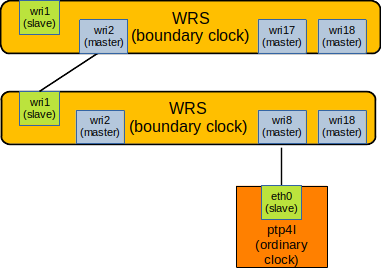You are here: Foswiki>Timing Web>TimingSystemDocumentation>TimingSystemHowTo>SynchronizeNonWrDevices (02 Jun 2022, EnkhboldOchirsuren)Edit Attach
Synchronize the clock of non-WR devices in the WR network
1. Introduction
This document presents specific configurations of White Rabbit (WR) switches, which are used to synchronize clock of non-WR nodes with the precision time protocol (PTP).2. PTP and WR
The precision time protocol (PTP) is dedicated to synchronize clocks in measurement, control and telecommunication systems communicating by local area networks (LAN) and is defined in the IEEE 1588 standards. It works with a master-slave architecture. The slaves are synchronized to their masters, which may be slaves to their own masters. The standard defines how master and slaves communicate and where timestamps are generated and how the differences are calculated. When the time stamping is assisted by hardware, it provides synchronization accuracy to the sub-microsecond level. The PTP protocol can be enhanced with profiles to meet the specific use-case requirements. In the accelerator timing systems of CERN and GSI/FAIR a high-accuracy profile of PTP, so called White Rabbit (WR) is deployed. WR can push the standard PTP accuracy to the sub-nanosecond level by utilizing synchronous Ethernet (SyncE) technology and a dedicated phase detection hardware to synchronize clock frequencies of master and slave clocks.2. WR timing network
The GSI timing system basically consists of GPS displined oscillator (GSPDO), a WR grandmaster and multiple WR boundary clocks. All WR grandmaster and boundary clocks are WR switches (WRS). They implement the IEEE 1588-2008 (PTPv2) and IEEE 1588-2019 (PTPv2.1) standards partially and supports following configurations (user manual in pdf and FAQ):- 2-step only
- multicast only
- request-response and peer-to-peer delay mechanisms (per port)
- Layer 2 (raw) and Layer 3 (UDP/IPv4) transport (per port)
- assignment of fixed master/slave role (per port)
- rx/tx delays (per port)
3. Configurations of WRS
The clock synchronization of non-WR devices in the WR network is demonstrated between a boundary clock (WRS) and an ordinary clock (non-WR device). A clock with only one port is called an ordinary clock (OC) and it can be master or slave. A clock with multiple ports is called a boundary clock (BC) and it can be master on one port and slaves on other ports. Figure 1. PTP clock synchronization in the WR network
There are several implementations of PTP in software. One of them is the linuxptp project.
It includes a command-line tool, ptp4l, that implements the PTP boundary clock and ordinary clock. Hence, it is chosen as PTP OC in this work and runs on a Linux host with GbE network card (software time stamping is used). The connection to WRS is done via an Ethernet cable and a copper SFP module. A sample configuration for ptp4l (used in this demo) can be found in an attached file.
An WRS is chosen as an PTP BC. For PTP following 3 settings are taken into account:
Figure 1. PTP clock synchronization in the WR network
There are several implementations of PTP in software. One of them is the linuxptp project.
It includes a command-line tool, ptp4l, that implements the PTP boundary clock and ordinary clock. Hence, it is chosen as PTP OC in this work and runs on a Linux host with GbE network card (software time stamping is used). The connection to WRS is done via an Ethernet cable and a copper SFP module. A sample configuration for ptp4l (used in this demo) can be found in an attached file.
An WRS is chosen as an PTP BC. For PTP following 3 settings are taken into account: - transport layer: layer 2 (raw Ethernet) and layer 3 (UDPv4)
- delay mechanism: end-to-end (E2E), peer-to-peer (P2P)
- profile: WR and PTP
- default: VLAN is disabled, wri1 is slave clock, wri2-18 are master clocks
- access-layer: VLAN is enabled, wri1 is slave clock, wri2-18 are master clocks
| WRS model | transport | delay mechanism | profile | is non-WR device locked? | comment |
|---|---|---|---|---|---|
| WRS-3/18 | Layer 2 (raw Ethernet) | E2E, P2P | WR, PTP | yes | |
| Layer 3 (UDP/IPv4) | yes | refer to Note 1 |
| WRS model | transport | delay mechanism | profile | is non-WR device locked? | comment |
|---|---|---|---|---|---|
| WRS-3/18 | Layer 2 (raw Ethernet) | E2E, P2P | WR, PTP | yes | |
| Layer 3 (UDP/IPv4) | no | refer to Notes 1 and 2 |
4. Safety consideration and a buffer WRS
A previous experiment shows that excessive incoming PTP and LLDP traffic can cause frame loss in WRS and lead to failure in WR synchronization. In order to block incoming traffic from the PTP network segment an additional WRS with the default configuration can be connected between an access-layer WRS and non-WR devices as a buffer WRS. With such cascaded connection traffic from the buffer WRS is blocked by the access-layer WRS: the MAC address of the up-link port of the buffer WRS is unknown, therefore it is handled as unregistered device. All outgoing traffic from the access-layer WRS are normally forwarded to the buffer WRS. -- EnkhboldOchirsuren - 02 Jun 2022| I | Attachment | Action | Size | Date | Who | Comment |
|---|---|---|---|---|---|---|
| |
ptp_clocks_in_wr_network.png | manage | 20 K | 02 Jun 2022 - 13:20 | EnkhboldOchirsuren | PTP clock synchronization in the WR network |
| |
wr.cfg | manage | 2 K | 02 Jun 2022 - 13:22 | EnkhboldOchirsuren | configuration for ptp4l |
Edit | Attach | Print version | History: r1 | Backlinks | View wiki text | Edit wiki text | More topic actions
Topic revision: r1 - 02 Jun 2022, EnkhboldOchirsuren
 Copyright © by the contributing authors. All material on this collaboration platform is the property of the contributing authors.
Copyright © by the contributing authors. All material on this collaboration platform is the property of the contributing authors. Ideas, requests, problems regarding Foswiki? Send feedback


